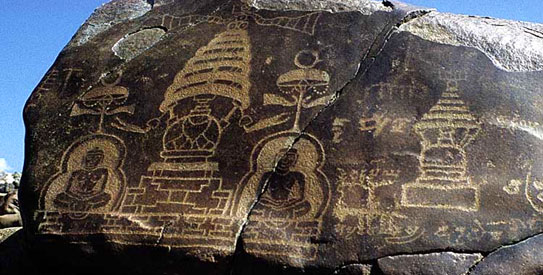30,000 Ancient Rock Embodies Will Submerge Under Basha Dam
The construction of Basha Dam threatens nearly 30,000 priceless ancient rock carvings and inscriptions, erasing a vital part of Pakistan’s cultural and archaeological heritage.
An assemblage of inscriptions and carvings from various eras suggests that this remarkable legacy is in danger of being destroyed at the proposed Diamer-Basha Dam site. The mountainous area of Pakistan situated between the Hindukush to the west, the Korakoram to the east, and the western Himalayas. Here, the confluence of historic routes turned the upper Indus into a crossroads and cradle for several civilizations.
READ MORE: List of Prohibited and Restricted Border Areas in Pakistan
The legendary silk route and its branches were used by invaders, merchants, pilgrims, travelers, researchers, and artisans from various origins, religions, times, eras, and cultures to enter the region. On the rocks, boulders, and cliffs, many of them have left their religious and cultural symbols.
More tourists and settlers were drawn to the smooth, sun-tanned rocks, where they carved their own names, numbers, inscriptions, and artwork. Thus, over time, a collection of rock art grew in the area, eventually transforming into a marvelland with about 50,000 rock carvings and 5,000 inscriptions from various civilizations dating from the eighth millennium BC to the arrival of Islam (dating back to the 16th century AD).
Due to the variety of the rock carvings in the area, it has become one of the most significant petroglyph gathering places worldwide.
Although there are significant numbers of rock carvings at the Shatial, Thor, Hodur, Thalpan, Naupura, Chaghdo, and other locations in northern Pakistan, the Basha-Diamer region is home to thousands of extremely significant rock carvings.
Hundreds of inscriptions in languages including Brahmi, Sogdian, Tibetan, Chinese, and even ancient Hebrew can be found at the site. Approximately 80% of the texts are written in Brahmi.
These writings not only shed light on the political and religious climate of the time, but they also list the rulers’ names and approximate dates. The experts were able to arrange the inscriptions chronologically thanks to these specific details.
Karl Eugen, a Hungarian traveler, found a Buddhist carving in modern-day Baltistan in 1884. Ghulam Muhammad, a seasoned explorer, revealed another Buddhist petroglyph from the Diamer district in 1907.
Karl Jettmar, a German scholar, was inspired to further explore the wealth of rock art when thousands more engravings became visible following the 1978 opening of the 750 km Karakorum Highway, also known as the modern Silk Road.
Karl Jettmar and Ahmed Hassan Dani, the father of Pakistani archaeology, established a German-Pakistani study group in 1980 with the goal of methodically examining the prehistoric rock art in the area.
Initiated in 1983, the study “Rock Carvings and Inscriptions along the Karakorum Highway” is another one. The study group was overseen by the Gilgit Department of Archaeology and the Heidelberg Academy of Humanities and Sciences. Since 1989, Professor Harald Hauptmann has led the project as Jettmar’s replacement.
The first horse carvings were discovered in the area during the third millennium BC, when agriculture began. Then, at the start of the first millennium BC, new ethnic groups, like the Sakan tribes, began to invade the region. The majority of the Eurasian animals they carved were incredibly fascinating, strange, and mythical in nature.
A later group of carvings emerged, this time depicting more mythological animals, horses, and warriors dressed in Persian garb. These illustrated the Achaemenid Empire’s growth in the sixth century BC and the influence of Iran in the area.
Buddhism became the dominant belief system in the region in the first century AD and peaked in the fifth and eighth centuries. During the same period, numerous amazing sculptures of Buddha and stupas—holy structures—as well as associated inscriptions were discovered.
According to Hauptmann, the discovery of old Indian style Khorashti language or Sanskrit in this region marked the beginning of the early Buddhist historical period. The names of various kings and the veneration of the Buddha indicate the pinnacle of Buddhism in this region.
While there is an immediate need to address Pakistan’s energy crisis and the construction of the Basha Dam would help close the power gap, it is also crucial to preserve and mitigate these carvings.
Hauptmann said, “We (as archaeologists) have to respect the decision (to build the dam) but it is very sad for us to lose one of the most rich and diverse rock art provinces of the world.” This was in response to a question concerning the need for the dam and the mitigation of the rock carvings.
Hauptmann claims that the Basha Dam will cause more than 25,000 people to be displaced and drown 32 villages.
He went on to say that after the dam is built, about 3,000 extremely significant stupas and a comparable amount of drawings will be submerged. He advocated for the creation of a cultural center in Gilgit that would house scientific records about the history, topography, languages, music, fauna, and other facets of the northern regions in addition to original and duplicate carvings.
This center could serve as a gathering place for academics, authors, tourists, and future generations interested in learning about the fascinating history of the area.
The fascinating tale of the enigmatic gold-digging ants is another reason for the area’s fame.
As they dug up the burrows where people would gather them to extract gold, the creatures piled up dust and dirt.
“The sands of the Indus have long been celebrated for the production of gold,” Alexander Cunningham said in 1854.


Comments are closed, but trackbacks and pingbacks are open.